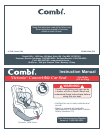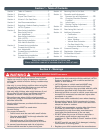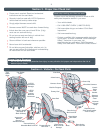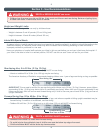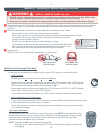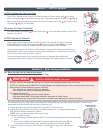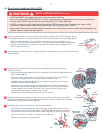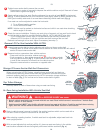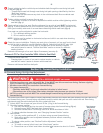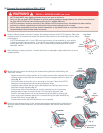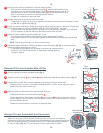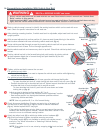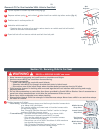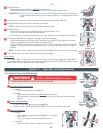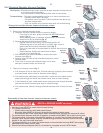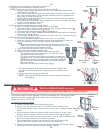
7
Section 6 - Selecting A Vehicle Seating Location
The National Highway Traffic Safety Administration (NHTSA) alerts vehicle owners that according to accident statistics,
children up to age 12 are safer when properly restrained in the rear seating positions rather than the front seating
positions.
Refer to vehicle owner’s manual for car seat installation instructions for your vehicle.
- Use car seat in a rear vehicle seat location whenever possible.
- Never use a car seat in a front seat location unless recommended by vehicle owner’s manual.
- For vehicles with air bags, always follow child restraint installation information
provided in vehicle owner’s manual.
DO NOT use car seat rear-facing on front seat with an air bag.
For a toddler over one year old and forward-facing, if a vehicle front seat location
with an air bag must be used, follow the vehicle manufacturer’s instructions for
child restraint use and move the vehicle seat back as far as possible.
Vehicle seats:
DO NOT use this Car Seat on the following types of vehicle seats:
1
2
Seats Which Face
Sides Of Vehicle
Seats Which Face
Rear Of Vehicle
•DONOT use this child restraint rear-facing in a vehicle front seating location with an air bag. Child’s head
and neck may be seriously injured when an inflating air bag hits back of child restraint.
• Never put a car seat in a vehicle front seating location unless recommended by vehicle owner’s manual.
WARNING
DEATH or SERIOUS INJURY can occur
DO NOT place rear-facing child seat
on front seat with air bag. DEATH OR
SERIOUS INJURY can occur.
The back seat is the safest place for
children 12 and under.
NO coloque el asiento infantil para el automóvil orientado hacia
atrás en el asiento delantero del vehículo que tenga una bolsa
neumática de seguridad. El niño podría MORIR O SUFRIR
LESIONES GRAVES. El asiento trasero es el lugar más seguro
para los niños de 12 años o menores.
WARNING
3
Options For Securing
A Car Seat:
This car seat can be secured to a vehicle using the new LATCH System or a vehicle seat belt.
1. LATCH System:
LATCH stands for Lower Anchors and Tethers for CHildren.
Starting with model year 2003 vehicles are equipped with LATCH Systems. See “LATCH System”
section for more information. Check vehicle owner’s manual to determine if your vehicle has the
LATCH System that may be identified with the symbol in fig. c.
Some vehicle owner’s manuals may identify the LATCH System as “ISOFIX”. An ISOFIX System
can be used in the same way as the LATCH System.
If your vehicle has the LATCH System, the LATCH System should be used whenever possible.
2. V
ehicle Seat Belt and Top Tether Strap:
If your vehicle does not have the LATCH System, the car seat MUST be secured to the vehicle using
a vehicle seat belt and top tether strap as required.
Check vehicle owner’s manual for seating locations recommended for car seat use and location
of top tether anchorages.
T
op Tether Information:
If a top tether anchor is not available in your vehicle, the car seat MUST be secured with only the
vehicle seat belt until a top tether anchor can be installed. For those passenger vehicles or buses
where top tether anchors are not available, the car seat may be used without the top tether
provided a secure installation can be achieved.
NOTE:Top tether is NOT used in the rear-facing position.
When not in use, store top tether and LATCH lower anchor belt by snapping onto back of
base (fig. d).
(fig. c)
8
(fig. d)



